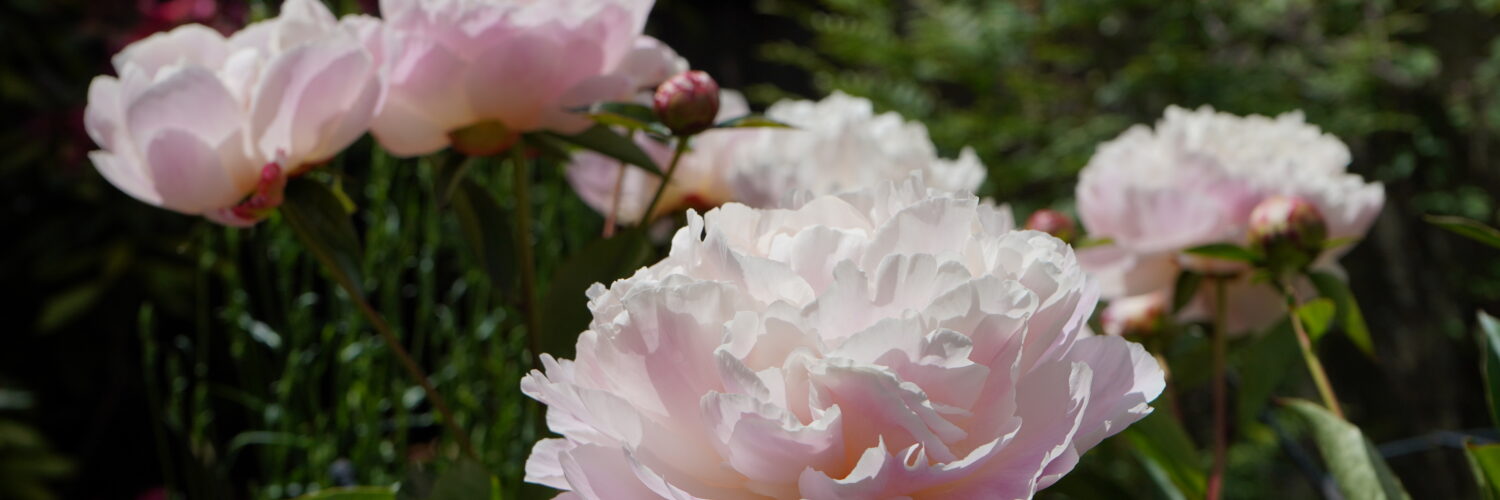
The peony, known as the “Queen of Flowers,” is celebrated not only for its stunning blossoms but also for its medicinal properties and rich cultural significance. As a traditional ornamental and medicinal plant, the peony has a long history of cultivation and wide-ranging applications in China.
Morphological Characteristics
The peony is a perennial herb with robust, spindle-shaped or oblong roots. Its stems are erect, typically reaching heights of 60-100 centimeters. The leaves are pinnately compound, deeply lobed, and either green or purple, with smooth surfaces. Each early summer, the peony’s flowers bloom magnificently, with diameters of 10-20 centimeters. The petals are layered, and the flowers come in a variety of colors, including white, pink, red, and purple.
Growing Environment
Peonies thrive in warm, moist climates and prefer locations with ample sunlight and good drainage. They are not particularly demanding regarding soil, but they grow best in fertile, loose loam. Peonies are highly frost-resistant but require adequate water and nutrient supply during the growing season.
Medicinal Value
Peonies have been widely used in traditional Chinese medicine for centuries. Their roots contain a wealth of compounds, such as paeoniflorin, tannins, and volatile oils, which have analgesic, anti-inflammatory, antibacterial, and immune-regulating properties. Peonies are primarily used to treat conditions like dysmenorrhea, headaches, abdominal pain, and rheumatoid arthritis. Additionally, peonies help improve blood circulation, regulate liver function, and provide significant health benefits.
Horticultural Uses
Due to their beautiful flowers and diverse colors, peonies hold an important place in horticulture. They are often planted in gardens, parks, and flowerbeds to enhance the environment and add aesthetic appeal. Peonies have a long blooming period, from May to June each year, providing extended visual enjoyment. They can be planted alone or combined with other flowers to create stunning floral arrangements.
Cultural Significance
In Chinese culture, the peony symbolizes beauty, happiness, and prosperity. In ancient poetry, peonies are often used to describe beautiful women or express the poet’s emotions. Peonies are also significant in traditional Chinese weddings, symbolizing a happy and harmonious marriage.
Conclusion
The peony, with its beautiful appearance, medicinal value, and cultural significance, is an indispensable plant in people’s hearts. Whether in horticultural appreciation or traditional medicine, peonies play a crucial role. Understanding and appreciating peonies can not only enhance our knowledge of plants but also enrich our cultural life and improve our health.
모란은 아름다운 꽃과 함께 의약적 특성 및 풍부한 문화적 의미로 인해 “꽃의 여왕”으로 칭송받고 있습니다. 전통적인 관상 및 약용 식물로서, 모란은 오랜 재배 역사를 가지고 있으며, 중국에서 광범위하게 활용되고 있습니다.
형태적 특징
모란은 다년생 초본식물로 강건한 방추형 또는 긴 타원형 뿌리를 가지고 있습니다. 줄기는 직립하며 일반적으로 높이가 60-100 센티미터에 이릅니다. 잎은 깃털 모양으로 깊게 갈라져 있으며, 녹색 또는 보라색으로 매끄러운 표면을 가집니다. 매년 초여름, 모란의 꽃은 지름 10-20 센티미터의 화려한 꽃으로 피어납니다. 꽃잎은 겹겹이 쌓여 있으며, 흰색, 분홍색, 빨간색, 보라색 등 다양한 색상을 자랑합니다.
생장 환경
모란은 따뜻하고 습한 기후를 좋아하며, 햇빛이 풍부하고 배수가 잘되는 장소를 선호합니다. 토양에 대한 요구가 많지 않지만, 비옥하고 느슨한 양토에서 가장 잘 자랍니다. 모란은 매우 내한성이 강하지만 생장 기간 동안 충분한 물과 영양 공급이 필요합니다.
약용 가치
모란은 수세기 동안 중국 전통 의학에서 널리 사용되었습니다. 그 뿌리는 진통, 항염, 항균, 면역 조절 등의 효능을 가진 다양한 화합물, 예를 들어 파에오니플로린, 탄닌 및 휘발성 오일을 포함하고 있습니다. 모란은 주로 생리통, 두통, 복통, 류마티스 관절염 등의 질환을 치료하는 데 사용됩니다. 또한, 모란은 혈액 순환을 개선하고 간 기능을 조절하며, 상당한 건강상의 이점을 제공합니다.
원예적 용도
아름다운 꽃과 다양한 색상 덕분에 모란은 원예에서 중요한 위치를 차지하고 있습니다. 모란은 정원, 공원 및 화단에 자주 심어져 환경을 개선하고 미적 매력을 더합니다. 모란은 매년 5월부터 6월까지 긴 개화 기간을 가지고 있어 오랜 기간 동안 시각적 즐거움을 제공합니다. 단독으로 심거나 다른 꽃과 함께 조화롭게 배치하여 아름다운 꽃꽂이를 만들 수 있습니다.
문화적 의의
중국 문화에서 모란은 아름다움, 행복, 번영을 상징합니다. 고대 시에서 모란은 종종 아름다운 여인을 묘사하거나 시인의 감정을 표현하는 데 사용됩니다. 또한, 모란은 전통 중국 결혼식에서 중요한 의미를 가지며, 행복하고 조화로운 결혼을 상징합니다.
결론
모란은 그 아름다운 외모, 약용 가치 및 문화적 의미로 인해 사람들의 마음 속에 없어서는 안 될 식물입니다. 원예 감상이나 전통 의학에서 모란은 중요한 역할을 합니다. 모란을 이해하고 감상하는 것은 식물에 대한 우리의 지식을 향상시킬 뿐만 아니라, 문화 생활을 풍요롭게 하고 건강을 증진시키는 데 도움이 됩니다.
芍药被誉为“花中皇后”,不仅以其美丽的花姿闻名于世,还因其丰富的药用价值和深厚的文化内涵而受到人们的喜爱。作为一种传统的观赏花卉和药用植物,芍药在中国有着悠久的种植历史和广泛的应用。
形态特征
芍药为多年生草本植物,根粗壮,呈纺锤形或长圆形。它的茎直立,通常高度在60-100厘米之间。芍药的叶子为羽状复叶,叶片深裂,呈绿色或紫色,叶面光滑。每年初夏,芍药的花朵绽放,花径可达10-20厘米,花瓣层层叠叠,花色丰富多样,包括白色、粉色、红色和紫色等。
生长环境
芍药喜欢温暖湿润的气候,适宜生长在阳光充足、排水良好的地方。它对土壤要求不高,但在肥沃、疏松的壤土中生长最好。芍药耐寒性强,但在生长季节需要充足的水分和养分供应。
药用价值
芍药自古以来就被广泛应用于中医药中。其根部含有丰富的芍药苷、单宁、挥发油等成分,具有镇痛、抗炎、抗菌和调节免疫等多种功效。芍药主要用于治疗痛经、头痛、腹痛、风湿性关节炎等疾病。此外,芍药还有助于改善血液循环,调节肝脏功能,具有显著的保健作用。
园艺应用
由于其花型美丽、花色丰富,芍药在园艺中有着重要地位。它常被种植于庭院、公园和花坛中,用于美化环境和增添景观。芍药花期较长,从每年5月到6月持续绽放,给人们带来长时间的视觉享受。它不仅可以单独种植,也可以与其他花卉搭配种植,形成美丽的花卉组合。
文化意义
芍药在中国文化中象征着美丽、幸福和繁荣。在古代诗词中,芍药常被用来比喻美女或寄托诗人的情感。唐代诗人杜牧在《芍药》一诗中写道:“芍药承春宠,何曾羡牡丹。”这句诗表达了他对芍药的喜爱和赞美。芍药还是中国传统婚礼中的重要装饰花卉,被认为是幸福与美满婚姻的象征。
总结
芍药以其美丽的花姿、丰富的药用价值和深厚的文化内涵,成为人们心中不可或缺的植物。无论是在园艺观赏中,还是在中医药应用中,芍药都发挥着重要作用。了解和欣赏芍药,不仅可以增进我们对植物的认识,还能丰富我们的文化生活,提升我们的健康水平。





Add comment